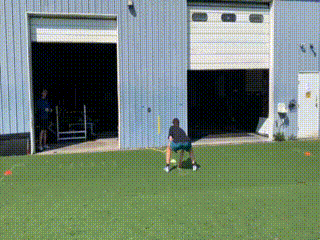20 Yard Shuttle
Improve Your 20-Yard Shuttle: The Ultimate Guide
Open field sports require speed. Faster athletes have an easier time of making people miss, getting into the open field, and creating scoring opportunities. Being fast gives an advantage.
Open field sports, like soccer, football, lacrosse, and field hockey are all examples of open skill sports. Open skill sports require real time, of the moment decision making skills to execute athletic movements to benefit the team. The open skill environment makes for a lot of change of direction and opportunities to make people miss.
Because open skills sports are a controlled form of chaos, athletes don’t spend much time reaching top end speed. Instead, they are routinely accelerating as quickly as possible, pumping the brakes, and going in another direction to create beneficial opportunities for the team.
A great drill for improving the ability to change direction in open skill sports is the 20-yard shuttle.
Change Of Direction
Most people think of speed and they think of 100 meter and 200 meter sprinters running sprints at max speed. Most people aren’t wrong. Track and field athletes are incredibly fast and excellent representations of speed incarnate. But track and field sprinters are participating in closed skill sports. That means no opponent directly impacting their performance–yeah, they are racing, but the athlete in the other lane isn’t pushing the other sprinter like a defender in an open skill sport–and the athletic movement is the same execution to execution. Think of a thrower or weightlifter in this regard as well. The execution of the lift or throw is essentially the same every time it is performed. Thus a closed skill.
Where open skill sports have a lot more nuance when it comes to speed. For comparison, a sprinter never has to apply the brakes. They are all go. Not the case with open skill athletes when it comes to speed. Open skill athletes need to put on the brakes, slam the brakes, throttle down, and routinely change direction and tempo to get past defenders.
So, where sprinters and open skill athletes need to accelerate to get to moving as fast as possible as quickly as possible, only the open skill athletes have to deal with changing direction and slowing down the fastest to do so.
Yes, top end speed matters. It matters a lot. Improving top end speed improves acceleration, which is an important part of changing direction. However, putting on the brakes to change direction is important. Having the requisite strength to handle the forces when overcoming inertia is important as well.
Because change of direction is so important, athletes need to train the ability to change direction. And one of the greatest methods to train change of direction is the 20-yard shuttle drill.

20 Yard Shuttle
The 20-yard shuttle is a drill that has an athlete run five yards, change direction and run ten yards, change direction again and finish off running five yards. Some people refer to the drill as the 5-10-5 shuttle run.
The 20-yard shuttle run is part of the NFL combine and a pretty familiar movement to most football hopefuls.
Where the drill is so great is that it asks athletes to accelerate three times, pump the brakes twice, and change direction three times.
The 20-yard shuttle drill is set up with three cones or pylons. The best place to do the drill is on a football field with the distance marked off. If not done on a football field, three cones and a measuring tape will suffice.
Simply put one cone in the middle and then a cone five yards away in one direction and the other cone 5 yards away in the opposite direction. The three cones should be in a straight line with one another.
To perform the drill, the athlete starts at the middle cone. It doesn’t matter which side the athlete goes to first, right or left, just that they run the initial five yards to the cone. Having done that initial run, the athlete needs to change direction and sprint ten yards to the furthest cone. Reaching the furthest cone, the athlete changes direction again, sprints the final five yards past the middle cone. In this way, the middle cone serves as the start and finish line.
It is important to time the shuttle run. Most people will be using a handheld timer. Make sure to start the stopwatch as soon as the athlete moves to start running and stop the stopwatch the moment the athlete passes the middle cone.

20 Yard Shuttle Technique
When it comes to improving an athlete's change of direction and ensuring structural symmetry, it's essential to perform drills targeting both sides of the body. This approach highlights any discrepancies between the athlete's stronger and weaker sides. If an athlete can execute the drill with minimal time difference between each side, it’s a strong indication that they are structurally sound and symmetrical.
Here's a detailed breakdown of the drill to improve change of direction.
Starting Position:
- If the athlete is moving to the right side, they should start with their right hand down. Conversely, if they are moving to the left side, they should start with their left hand down.
- Ensure the start is centered to avoid cheating the line. This drill is used as a test to gauge the athlete's ability to change direction accurately, so an honest start is crucial for true results.
- Avoid placing too much weight on the down hand to maintain balance and readiness.

First Step:
- The first step is a crossover step, which happens almost simultaneously with the hip opening.
- For a right-side movement, the right hip opens while the left leg performs the crossover step. Think of driving across with this crossover step for maximum efficiency.

Movement to the First Cone:
- The sequence to the first cone involves four steps. The first cone is touched with the outside hand.
- Steps: Crossover step (1), step (2), another crossover step (3), and a plant step (4) to propel forward.
- Aim to be as linear as possible while taking eight steps to reach the next cone.
- The first four steps should be executed with maximum intensity

Approaching the Second Cone:
- Start decelerating on steps 5 and 6.
- Plant on step 7 and perform a jump cut on step 8. This jump cut needs to be precise to maintain a linear path rather than winding.
- Touch the line with the outside hand, turn, and sprint back with as much acceleration as possible.

By adhering to these detailed steps and ensuring symmetry in execution, athletes can significantly enhance their ability to change direction, leading to improved performance in their respective sports.
20 Yard Shuttle Benefits
Can’t overstate how beneficial the ability to change directions is when it comes to game time speed, especially for open skill athletes.
Although the 20-yard shuttle is itself a closed skill, in that it is controlled, no direct opponent interference, and the skill is repeatable and controlled, it still has great carry over to enhancing change of direction capabilities on the field.
Similar to how performing a snatch or power clean helps improve explosiveness, closed skill activities, or how bench pressing or squatting makes an athlete stronger, closed skills as well, the 20-yard shuttle improves an athlete’s agility.
The drill teaches athletes how to control their body, put on the brakes, and accelerate in a tight window. The multiple instances of changing direction, decelerating, and accelerating provide ample opportunities for creating a steep shin angle and maintaining the proper posture through dynamic trunk control to get in and out of the cuts.
Sample Speed Day Workout (Change Of Direction Focus)


The Bottom Line
The 20-yard shuttle is a great change of direction drill for athletes to utilize on a speed day to help develop acceleration, explosiveness, and change of direction capabilities Athletes of all varieties, especially open skilled sport athletes, can benefit greatly from utilizing the 20-yard shuttle drill in their training. Whether needing to make a cut to change direction on the field, cross up a defender on the court, or put on the brakes to make a defender miss, the 20-yard shuttle is a great drill to utilize to improve agility.
So, if you’re an athlete looking to up their athleticism, become more agile, or improve acceleration capabilities, head over to peakstrength.app and download Peak Strength our strength training app developed with athletes in mind so you can reap the benefits of becoming a more capable athlete through training.
Later.


EARL KUNKEL
3x World Champion Co-Author of the Year
King of the PA Press
Blog Topics

Yo, It's Dane
Welcome to the Garage Strength Blog, where it is my goal to provide you with the experience and knowledge I've gained in the strength and conditioning world over many years of learning from both successes and failures. I train elite-level athletes in a multitude of sports from the high school to professional levels, already producing 5 Olympics and 30+ National Champions. If you want to be the next champion I train, check out my strength programs below!
Start Training With Me

Join for free educational videos EVERY WEEK on strength coaching and athletic performance

